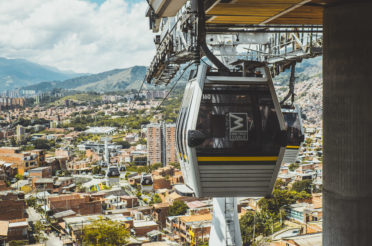Almost immediately as we entered Guatemala, we came face-to-face with a somewhat unusual breed of vehicles overtaking us on steep mountain roads. The best way to describe it would be to “imagine a typical North American school bus dressed up as a Las Vegas showgirl”, as another traveler has written.
These unorthodox vehicles have the form of a traditional yellow school bus, but this is often where the similarities end. Transporting upwards of 100 people at a time, with luggage overflowing on the roof, and an occasional livestock somewhere in between, they serve as one of the key ways for Guatemalans to get around on the cheap within the city or between far-off locales.
Called La Camionetas or “Chicken Buses”, the story of how they get to Guatemala and go on to live a second life here is fascinating and offers a glimpse in the global market forces that is not too visible in the U.S.
In the U.S., the ubiquitous school buses typically get retired after 10 years of use or about 150,000 miles. While they are typically meticulously maintained and in full working order, the government funding restricts how old the bus fleet can be in order to qualify for subsidies. At that time, the buses get sold off at an auction anywhere from $2,000 to $5,000. To put it into perspective, the original cost varies anywhere from $65,000 to $85,000.
At an auction, the buses will oftentimes get purchased by Guatemalans who drive in specifically for that purpose – often making a regular Guatemala to U.S. roundtrip every other week. The bus then will get driven across the U.S. – Mexico border, across Mexico, and into Guatemala to a designated shop to get prepared for their second lives.
Once at the shop, with a buyer secured, the bus will typically undergo a dramatic transformation and get pimped out. The engine and suspension will get beefed up, the luggage racks added inside and on top, the original yellow colors and labels will get stripped off and the entire bus will be repainted with unique murals and praises to Jesus, along the owner’s girlfriend’s name drawn out somewhere on the side and a healthy dose of chrome added all throughout.
The bus routes in Guatemala get auctioned off by the government to the highest bidders, almost always a private company who will operate a few buses. The company will rent out the buses to the drivers, who pay a flat daily fee and can keep everything they collect above that, thus encouraging slightly higher than average speeds and slightly higher than average occupancy.
The driver, in turn, is responsible for sub contracting a helper – “ayudante” – whose job it is to hang on the side of the bus, yelling out destinations to attract passengers, helping old ladies with their cargo, and occasionally popping out to stop other cars to let the bus get through a traffic jam.
These buses will then go on to zig-zag Guatemala’s cities and mountain roads transporting people and cargo – as one of the few reliable and affordable options available locally. Even as we were driving high up in the mountains or on slow-going back roads in Guatemala, we could nearly always count to see these buses pass through every so often.
What’s particularly remarkable about these buses is both the fact that they have found a way to give a new life to products that are pretty much discarded in the U.S., as well as the tremendous amount of creativity and artistic skill that goes into turning each bus into a moving reflection of the owner or driver’s personal style, be it machismo, religion, national pride, or a combination of a little bit of everything.
The Darker Side
There is a tragic side to these buses, however. Over the last decade, driving them has been decidedly one of the most dangerous jobs in the world – with over 900 driver deaths over a span of a few years.
The high danger level stems from several of the gangs becoming more widespread and violent in Guatemala, who started to look for additional ways to finance their activities and turned to the “taxation” of the bus drivers as the way. The gangs will commonly drop off a burner phone to the bus company’s owners and the anonymous voice will demand weekly fees for driving through their territories, often upwards of $1,000 USD a week.
If the owners refuse or are unable to pay, repercussions are swift and extremely violent with the gang members boarding the bus and shooting the drivers in broad daylight by the dozens. In a country where the number of private security guards of 150,000 is five times the size of the national police force of 30,000, the local government has not been able to effectively deal or control the problem.
Occasionally, the bus companies will hire their own security guards. More often, they will avoid stopping at designated stops and rather drop off and pick up passengers alongside of the road, thus trying to minimize their chances of becoming a target.
In spite of the risks, as we’ve gone through Guatemala, these buses, their drivers and passengers onboard, were ubiquitous and ever-present as the widespread network connecting the country and its people.
- There is an interesting article that follows the story of a particular bus company owner and their driver here.








Leave a Reply